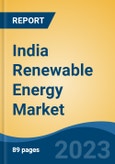Speak directly to the analyst to clarify any post sales queries you may have.
10% Free customizationThis report comes with 10% free customization, enabling you to add data that meets your specific business needs.
Key Market Drivers
Government Policies and Supportive Regulatory Framework
India’s renewable energy sector is significantly bolstered by a favorable policy environment and proactive government support. Initiatives such as the National Solar Mission aim to scale up solar capacity while driving down costs. Financial mechanisms including subsidies, viability gap funding, feed-in tariffs, and tax exemptions make renewable projects more viable.The enforcement of Renewable Purchase Obligations (RPOs) mandates utilities to source a fixed proportion of their electricity from renewables, ensuring continuous demand. Institutions like SECI and IREDA facilitate project development and financing, while competitive bidding processes have led to globally competitive tariffs, attracting significant investment. The government is also investing in infrastructure enhancements like the Green Energy Corridor to better integrate renewable sources into the national grid. With a target of reaching 500 GW of non-fossil fuel capacity by 2030, India is well-positioned as a key destination for clean energy investment.
Key Market Challenges
Grid Infrastructure and Integration Challenges
India’s existing grid infrastructure presents a critical challenge to the seamless adoption of renewable energy. Renewable sources such as solar and wind are inherently intermittent and weather-dependent, making consistent energy delivery difficult. The country’s aging transmission and distribution networks are ill-equipped to handle the decentralized and variable input from renewable sources, resulting in frequent curtailments. Many renewable-rich states produce more energy than they can consume, underscoring the need for efficient long-distance transmission. Grid congestion, technical losses, and insufficient real-time load balancing further hamper integration. Although programs like the Green Energy Corridor are in place, delays in implementation hinder progress. Without timely grid modernization, the scalability and reliability of renewable energy in India will remain constrained.Key Market Trends
Growth of Solar Rooftop Installations
The solar rooftop segment in India is gaining strong momentum, particularly across commercial, industrial, and increasingly, residential sectors. Driven by surging electricity costs, declining solar equipment prices, and supportive policies, rooftop systems are becoming a practical energy solution. The government’s target of 40 GW of rooftop capacity is supported by incentives, net metering, and simplified installation procedures.Net metering allows consumers to offset electricity bills by feeding surplus solar power back into the grid, enhancing economic appeal. The commercial and industrial sectors are leading adoption, leveraging available roof space and high daytime demand to cut energy costs and meet sustainability goals. In the residential market, rising awareness and innovative models like solar leasing and zero-upfront-cost financing are making rooftop installations more accessible. This decentralization of solar power generation is playing a vital role in India’s broader renewable energy ambitions.
Key Market Players
- NextEra Energy, Inc.
- Iberdrola, S.A.
- Enel S.p.A.
- Orsted A/S
- Siemens S.A.
- Vestas Wind Systems A/S
- Canadian Solar Inc.
- First Solar, Inc.
Report Scope:
In this report, the India Renewable Energy Market has been segmented into the following categories, in addition to the industry trends which have also been detailed below:India Renewable Energy Market, By Type:
- Hydroelectric Power
- Wind Power
- Bioenergy
- Solar Energy
- Others
India Renewable Energy Market, By End Use:
- Residential
- Commercial
- Industrial
- Others
India Renewable Energy Market, By Region:
- South India
- North India
- West India
- East India
Competitive Landscape
Company Profiles: Detailed analysis of the major companies present in the India Renewable Energy Market.Available Customizations:
With the given market data, the publisher offers customizations according to a company's specific needs. The following customization options are available for the report.Company Information
- Detailed analysis and profiling of additional market players (up to five).
This product will be delivered within 1-3 business days.
Table of Contents
Companies Mentioned
- NextEra Energy, Inc.
- Iberdrola, S.A.
- Enel S.p.A.
- Orsted A/S
- Siemens S.A.
- Vestas Wind Systems A/S
- Canadian Solar Inc.
- First Solar, Inc.
Table Information
| Report Attribute | Details |
|---|---|
| No. of Pages | 132 |
| Published | June 2025 |
| Forecast Period | 2025 - 2031 |
| Estimated Market Value ( USD | $ 19 Billion |
| Forecasted Market Value ( USD | $ 31 Billion |
| Compound Annual Growth Rate | 8.8% |
| Regions Covered | India |
| No. of Companies Mentioned | 8 |









